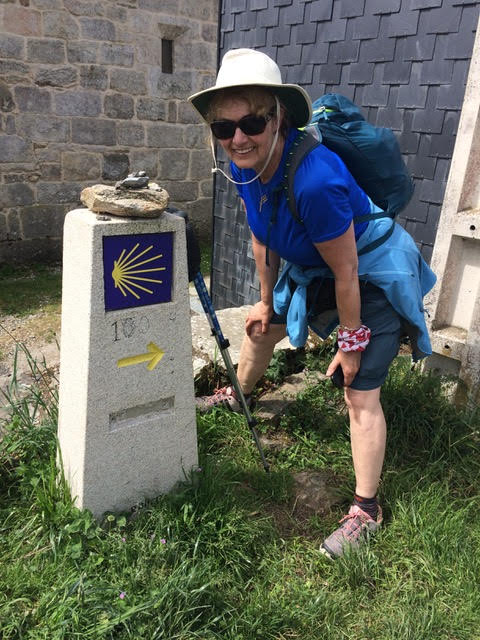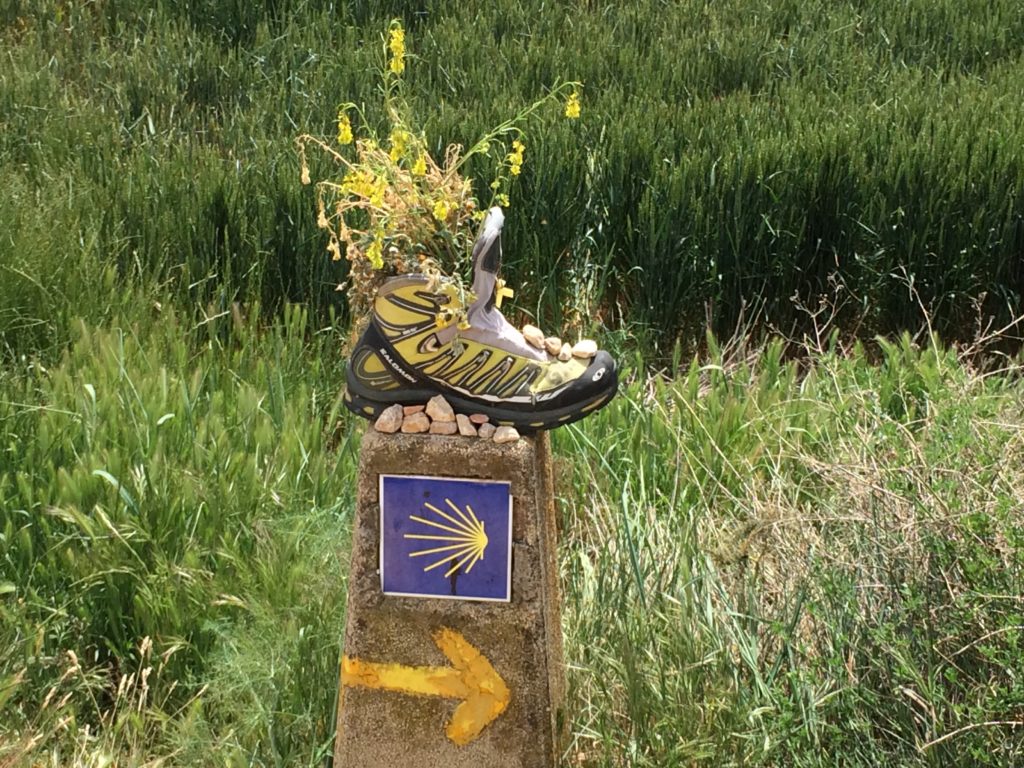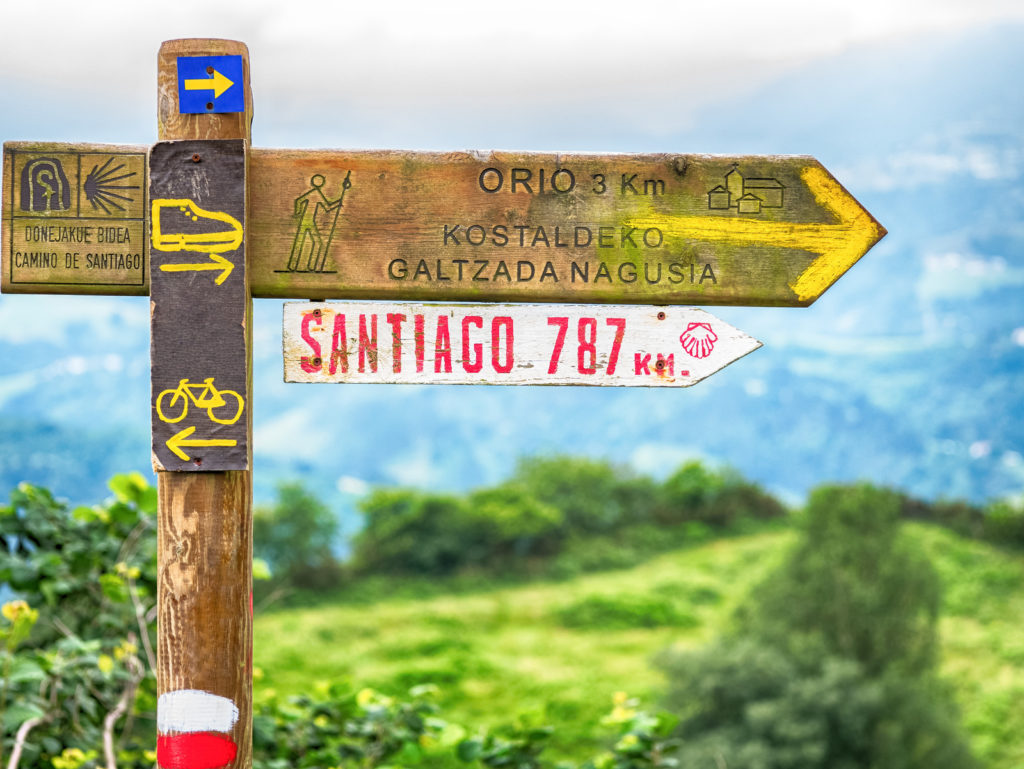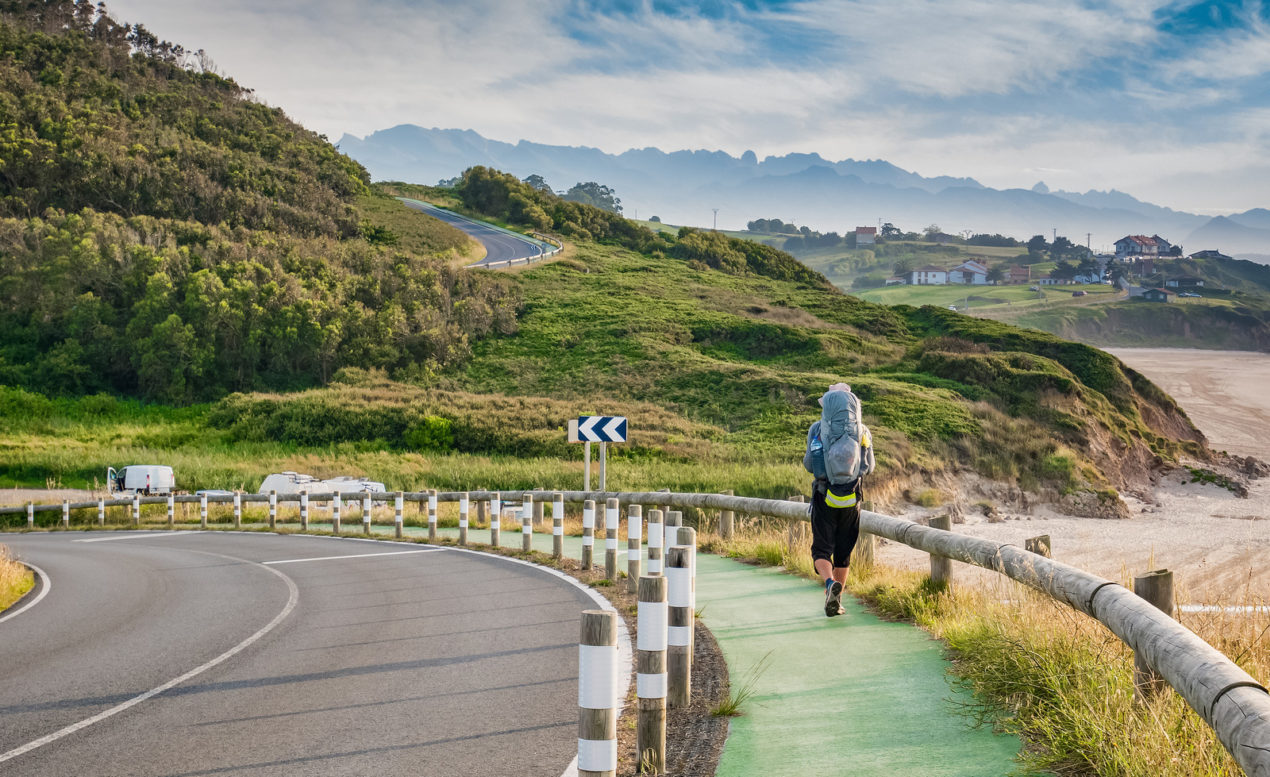Top Tips for Walking the Camino of Santiago
This post may contain affiliate links to products or services I'm happy to recommend. If you click on an affiliate link and then make a purchase, Artsy Traveler may earn a small commission at no cost to you. Thank you!
Everyone I know who has walked the Camino of Santiago (the Way) to Santiago de Compostela in northwest Spain raves about the experience.
My friend and guest poster Elizabeth Petrie is no exception. She and her friend, Cheri, walked the Camino from Pamplona to Burgos and from Sarria to Santiago, with train travel between Burgos, León, and Sarria.
Elizabeth shares her experiences and recommendations in three posts on Artsy Traveler. In this post, learn her top tips for enjoying the Camino of Santiago. To find out how Elizabeth and Cheri organized their walk, read A Camino Journal: Pamplona to Santiago de Compostela. Elizabeth’s recommendations for Burgos and León are included in Exploring Burgos and León.
Guest Poster Elizabeth Petrie
Retirement brings new opportunities, and one of my most cherished is having the chance to travel. New places, unique experiences, wonderful memories—what could be more enticing?
For a long time, walking across northern Spain on the Camino has topped my “bucket list.” My friend, Cheri, shared the same interest, so we decided to make plans to walk the Camino together.

Here are tips for helping you plan an awesome experience on the Camino of Santiago.
Prepare for the Camino of Santiago
Distance walking was new to me, so I started training about a year before leaving for Spain. Cheri and I began with modest treks of six to eight kilometers twice a week and worked up to walks of ten to twelve kilometers. By the time we left for Spain, we could comfortably walk about fourteen kilometers with our backpacks partially full.
Plan Your Itinerary
The Camino of Santiago extends across several countries and hundreds of kilometers. Start in France on the Camino Francés or complete all or a portion of the Camino del Norte like we did.
We put together an itinerary that included stays in four-star hotels in the cities we’d pass through: Pamplona, Burgos, León, and our final destination, Santiago de Compostela. We knew we’d appreciate a bit of luxury after days of slogging along and nights spent in the dormitory-like albergues.
An albergue is a hostel that provides accommodation only for pilgrims walking the Camino of Santiago. To stay in an albergue, you need to have a Pilgrims Passport.
Obtain a Pilgrims Passport
The Pilgrims Passport contains spaces for the sellos (stamps) that prove you’ve walked that day and are entitled to stay in one of the state-run albergues.
If you start the Camino from St. Jean in France or from Pamplona, like we did, you need to get one stamp per day. If you walk only the last 100 kilometers from Sarria, you need to get two stamps each day.
So long as you have sufficient stamps and you state at the Pilgrims Office in Santiago de Compostela that you’ve completed the Camino for religious or spiritual reasons, you’ll receive the Compostela at the end of the journey in Santiago.
If you state other reasons for completing the Camino, you receive a different certificate to commemorate your journey.
You can also get a passport at some albergues and pilgrims’ offices along the Way.
However, to save time, I recommend you obtain your Pilgrims Passport before you leave. To do so, connect with the Pilgrims’ Association in your home country.
Camino Websites for Canada, the UK, and the United States
- Canadian Company of Pilgrims
- Confraternity of Saint James in the United Kingdom
- American Pilgrims on the Camino in the United States.
For other organizations, search online for Pilgrims’ Association and the name of your country.
Choose When to Go
Consider walking the Camino in May or September. The weather from June to August is too hot, the hotel prices are higher, and the Way is much more crowded.
We found that May was perfect with regard to both the weather and the crowds (or lack of!). While you definitely won’t run into crowds in the winter months, be aware that many of the smaller albergues are closed from mid-October to mid-April.
Purchase a Guidebook
I recommend A Pilgrim’s Guide to the Camino de Santiago (Camino Francés): St. Jean – Roncesvalles – Santiago by John Brierley. The book includes all the information you’ll need: route and town maps, and the location of coffee shops, restaurants, and albergues. The book also lists telephone numbers of the albergues so that you can book ahead.
Plan Your Daily Walk Duration
Plan to walk no more than 15 to 18 kilometers in a day (about five hours), depending on the terrain.
This distance is long enough to give you a reasonable goal, time to stop for sightseeing and meals, and the best chance of finding accommodations. Also, we found that blisters started forming if we attempted to walk more than 22 kilometers in one day.
On most days, we left the albergue around 8 am and arrived at our next albergue in the mid-afternoon. The earlier you get to the albergue you plan to stay in, the better your chances of finding accommodations. Many albergues do not take reservations, although sometimes you can speak with the hospitalero and ask them to call ahead for you.
Book Accommodations for the Final 100 Kilometers
While you do not need to book accommodations along the early stretches of the Way (and often you cannot), you should book places to stay along the last 100 kilometers.
The Way becomes increasingly crowded the closer you get to Santiago. We used booking.com to book small hotels along the last stretch of the Way and were glad we did. Each place we booked was clean and conveniently located.
Walk the Camino of Santiago
Here are some tips for helping you enjoy your time on the Camino.
Use the Send-Ahead Pack Service
Send your main pack ahead and hike with just a day pack. The send-ahead service was well worth the few extra euros (usually €3 to €5 per pack). You can send your pack from any Camino albergue in the morning to the albergue at your next stopping point. Call ahead to make sure the albergue you plan on staying at has available beds and will be open when the van arrives with your pack.
Take a Day Pack
Pack the following items in your day pack:
- A full first-aid pack, complete with Compeed*and blister treatment, a needle and cotton thread, antibiotic ointment, Band-Aids, antiseptic spray, antihistamines, Afterbite, an elastic bandage, and sunscreen. You’ll find plenty of pharmacies along the Way in case you run out of anything.
- A liter of water. If you sweat a lot, you will occasionally need to supplement your water with a local version of Gatorade.
- A change of socks. Sweaty socks can bring on blisters.
- A change of shirt and rain gear if rain threatens.
- Fresh or dried fruit, nuts, protein, etc. Depending on your route for the day, you’ll usually find small coffee bars and restaurants along the Way where you can purchase lunch.
- Your passport, credit cards, and other essential documents. Also, carry a day’s worth of currency and never flash around large amounts of cash.
*Compeed is a miracle blister treatment available in Spanish farmacias.
I suggest stocking up on Compeed before you leave by buying it online. As soon as you feel a friction blister coming on, put the clear plastic Compeed over it and leave it on. You’ll never have another blister!
Limit Technology
On the Way, consider forgoing technology as much as possible. If you take a SmartPhone to check weather reports and make hotel bookings, particularly in the last 100 kilometers, purchase a cell phone package for Europe from your service provider or pick up a SIM card at a local provider such as Vodafone or Orange.
Use your phone to take pictures instead of carrying a heavy, expensive camera. Also, I suggest not wearing earbuds while you’re walking or you’ll miss the bird song and conversation.
One of my lasting memories on the Way is the sound of an amazing variety of bird songs.
Enjoy the Pilgrim’s Dinner
Have the pilgrim’s dinner when it’s offered at the albergues. You’ll get a cheap and tasty meal that includes soup or salad, a fish or pork entrée, dessert, and a glass of local wine. The local soups are delicious and filling.
Use Other Transportation as Needed
Consider occasionally taking a taxi or public transit when you get tired rather than risking injury. Walking the Camino in short stages will help conserve your energy.
Take Good Footwear
Wear hiking boots that are well broken in. Also, pack a pair of lighter shoes, such as Teva sandals, to occasionally give your feet a rest. Wear flip flops in the shower and around the albergue at the end of the day.

Enjoy Meeting New People on the Camino
A highlight of walking the Way is meeting many wonderful and interesting people. People in the albergues and elsewhere along the Camino could not do enough for us. We always left our packs closed, and they were never disturbed, even when we left them in dormitories to go sightseeing.
Slow Down
My best advice for walking the Camino is to slow down and savor the experience. In other words, stop and smell the roses!
Check out as many churches, shrines, historical sites, and civic plazas as you can. You’ll be amazed at the unexpected beauty and fascinating art and architecture.

Northern Spain has been home to human beings for tens of thousands of years, from Neanderthal times to the present. You can hardly take a step without passing a fascinating site of historical significance.
For example, on some sections of the Way, you’ll be following, if not actually walking on, the original Roman roads. And in some of the smaller villages where the Spanish Civil War was fought in the 1930s, you’ll still see bullet holes in the walls of old barns and houses.
Suggested Itinerary
For a detailed breakdown of our itinerary that started in Pamplona, Spain and included stops in Burgos and León,along with a few train journeys, see the post A Camino Journey: Pamplona to Santiago de Compostela.
I can’t imagine how our trip could have been any better. We enjoyed pretty much perfect weather, and we both kept well and healthy. In addition, we met interesting people, enjoyed delicious and reasonably-priced meals, and soaked up some of the rich history and culture of Navarra, La Rioja, and Galicia.
We also appreciated the spiritual nature of our journey to Santiago, taking time every day to reflect with humble gratitude upon our many blessings. Our trip was a pilgrimage in many senses of the word.
Do I recommend walking the Camino? Absolutely!
¡Vaya con Dios!

[…] the Way. If you’re interested in walking the Way yourself, read Elizabeth’s recommendations in Top Tips for Walking the Camino to Santiago de Compostela. And for suggestions about what to see and do in beautiful Burgos and León, read Exploring Burgos […]
[…] Top Tips for Walking the Camino of Santiago by Elizabeth Petrie […]
[…] Top Tips for Walking the Camino of Santiago by Elizabeth Petrie […]